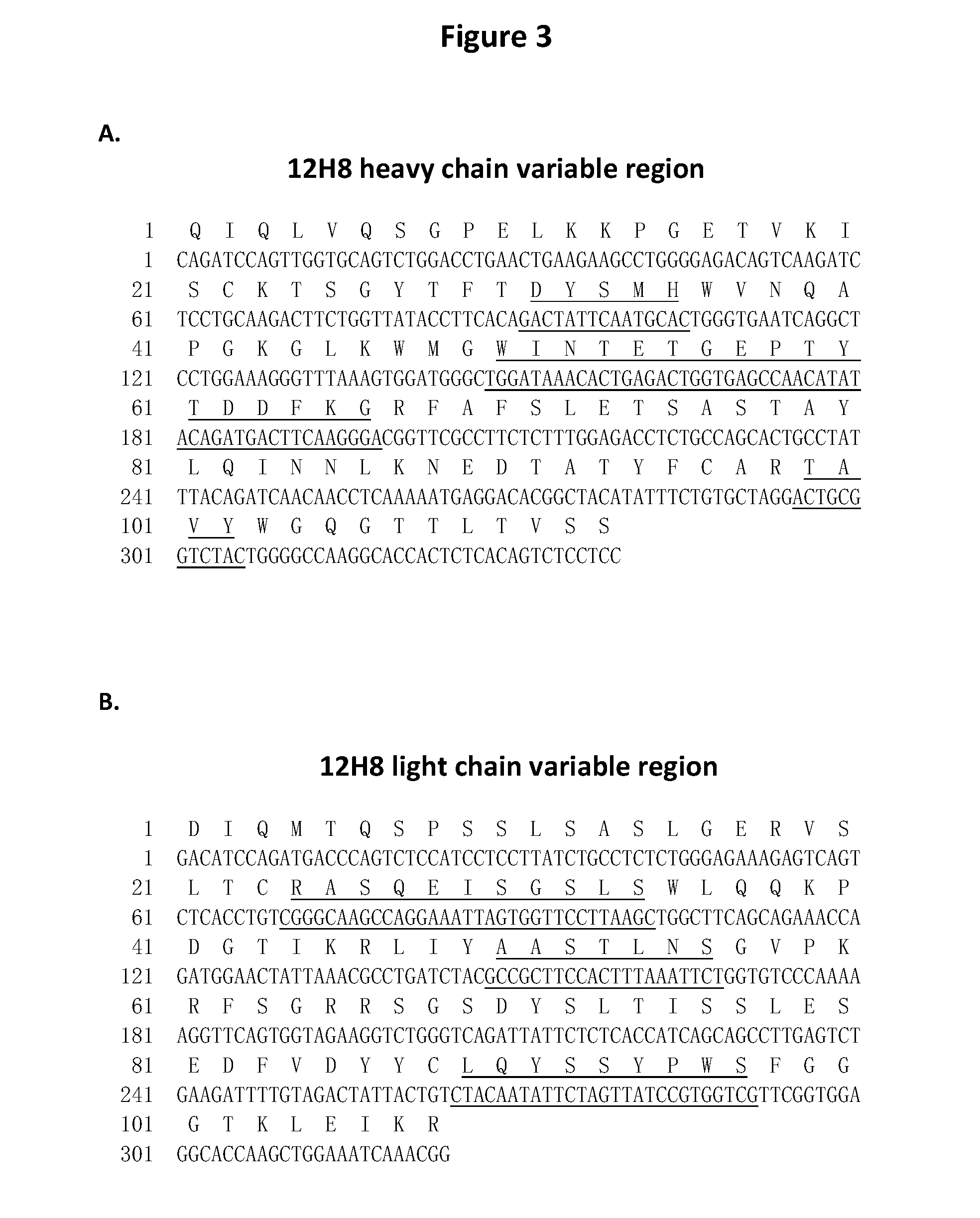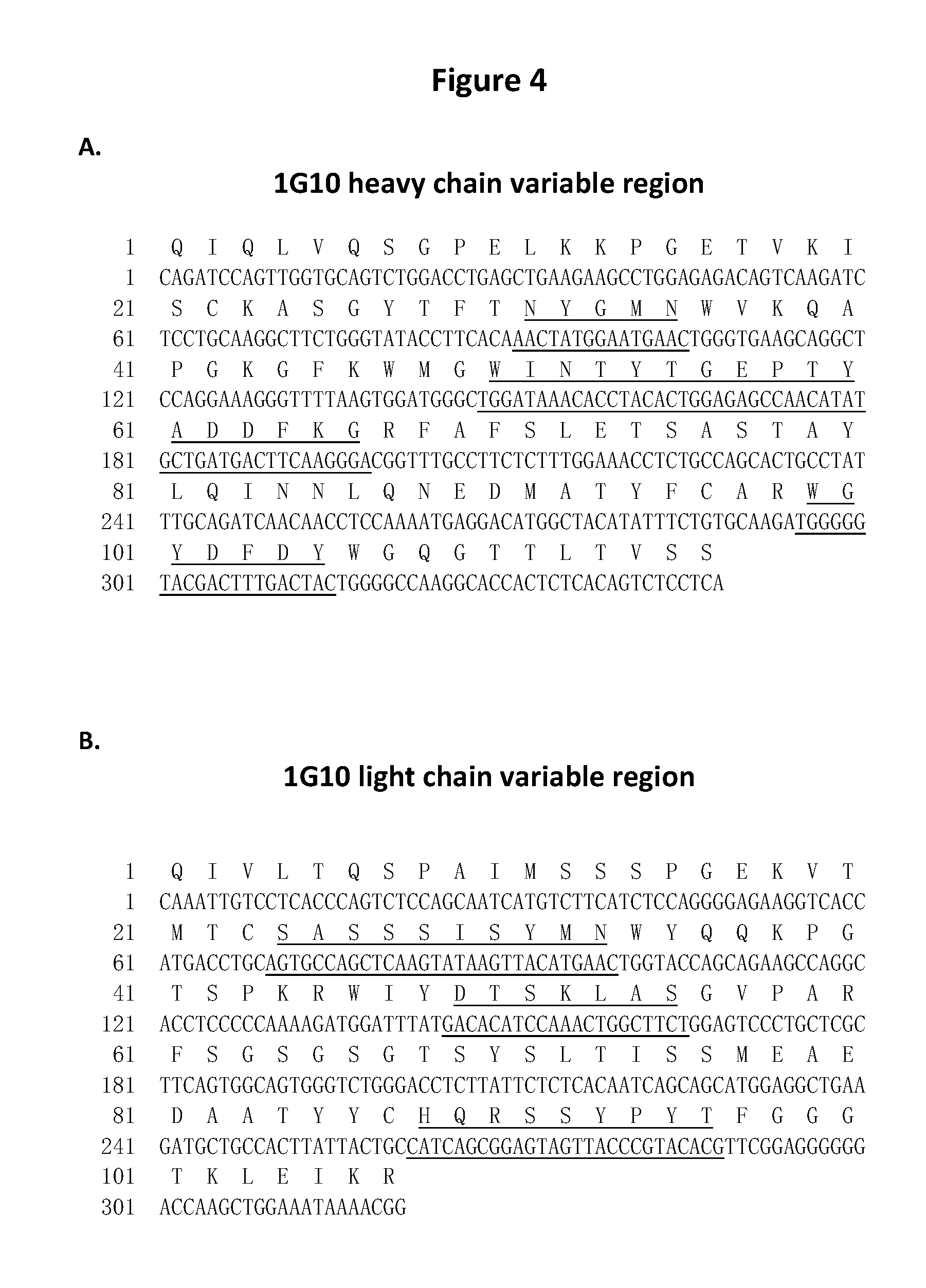Anti-epcam antibodies that induce apoptosis of cancer cells and methods using same
a technology of apoptosis and anti-epcam antibodies, which is applied in the field of anti-epcam antibodies that induce apoptosis of cancer cells and methods using same, can solve the problems of adverse effects and limited systemic use of such anti-epcam antibodies, and achieve the effects of preventing cancer, and reducing the risk of apoptosis
- Summary
- Abstract
- Description
- Claims
- Application Information
AI Technical Summary
Benefits of technology
Problems solved by technology
Method used
Image
Examples
example 1
Generation of Anti-hEpCAM Antibodies
[0213](1) Generation of Anti-hEpCAM Antibodies with Cancer Cells Immunization
[0214]Human breast carcinoma cell line, T-47D (BCRC 60250) and choriocarcinoma cell line, BeWo (CCRC 60073) were purchased from Food Industry Research and Development Institute, Hsin-chu, Taiwan. T-47D was maintained in RPMI 1640 medium (GIBCO BRL) with 2 mM L-glutamine adjusted to contain 1.5 g / L sodium bicarbonate, 4.5 g / L glucose, 10 mM HEPES, 1.0 mM sodium pyruvatem, and 0.2 Units / ml bovine insulin, 90%; and supplemented with 10% fetal bovine serum (FBS), 100 units / ml of penicillin and 100 μg / ml of streptomycin (GIBCO BRL) at 37° C. in a humidified atmosphere of 5% CO2. BeWo was grown in 85% Ham's F12K medium (GIBCO BRL) with 2 mM L-glutamine adjusted to contain 1.5 g / L sodium bicarbonate, 85%; and supplemented with 15% FBS, 100 units / ml of penicillin and 100 μg / ml of streptomycin (GIBCO BRL) at 37° C. in a humidified atmosphere of 5% CO2.
[0215]Balb / c mice were immuni...
example 2
Characterization of Anti-EpCAM Clones Generated
(1) Establishment of CHO / EpCAM Cell Line
[0218]The cDNAs encoding full-length of human EpCAM (aa 1-314) were amplified by PCR from the cDNA pool generated from T-47D cells and cloned into the modified pcDNA 3.1 / Myc-His(+) A vector (Invitrogen), followed by transfecting into Chinese hamster ovary (CHO) cells at 80-90% confluence in 6-well culture dishes, using Lipofectamine 2000 (Invitrogen, Cat. No. 11668-500). Transfectants were selected in F12 / 10% FBS medium containing 600 ug / ml Hygromycin B (C.A. IN-10687-010). Transfected cells expressing hEpCAM were identified by flow cytometry with anti-EpCAM antibodies.
(2) Binding of Selected Anti-EpCAM Clones to CHO / EpCAM Cells
[0219]1×105 CHO / EpCAM or CHO parental cells were seeded in each well of a v-bottomed 96-well plate and incubated with purified anti-EpCAM antibodies or mouse IgG control antibody 9E10 at concentration of 0.1 μg / ml. A 300× dilution of human cell hyper-immune serum (HPS 300×)...
example 3
Cytotoxic Effect of Anti-EpCAM Antibodies in Cancer Cell Lines
(1) Cytotoxicity of Anti-EpCAM Antibodies in Variant Cancer Cell Lines.
[0221]For antibody cytotoxicity assay, 4-5×104 cancer cells were seeded to each well of a flat-bottomed 96-well plate, and then different concentrations (1, 3, or 10 μg / ml) of anti-EpCAM (12H8, 1G10, 1F10, 2D11, 6D11 and 4D2) or control (9E10) antibody, diluted in the medium was added into the cells. After a 17-20 hr incubation at 37° C., cells were stained with 0.3 μl of FITC-conjugated Annexin V (Strong Biotech Corp. Cat. No. AVK250) in 50 μl Annexin V binding buffer (Strong Biotech Corp. Cat. No. AVK250) at RT for 20 min. After wash, the cells were then stained with 0.3 μl of propidium iodide in 200 μl Annexin V binding buffer. Annexin V and Propidium Iodide were used as a joint indicator for cell death. The data were acquired with BD FACSCalibur based on an acquisition of 3,000-5,000 cells and analyzed with the Cell Quest software. The combined per...
PUM
| Property | Measurement | Unit |
|---|---|---|
| concentration | aaaaa | aaaaa |
| dissociation constant | aaaaa | aaaaa |
| dissociation constant | aaaaa | aaaaa |
Abstract
Description
Claims
Application Information
 Login to View More
Login to View More - R&D
- Intellectual Property
- Life Sciences
- Materials
- Tech Scout
- Unparalleled Data Quality
- Higher Quality Content
- 60% Fewer Hallucinations
Browse by: Latest US Patents, China's latest patents, Technical Efficacy Thesaurus, Application Domain, Technology Topic, Popular Technical Reports.
© 2025 PatSnap. All rights reserved.Legal|Privacy policy|Modern Slavery Act Transparency Statement|Sitemap|About US| Contact US: help@patsnap.com



